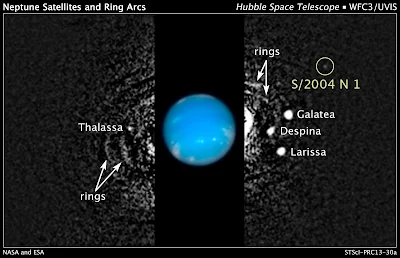Ο
νέος δορυφόρος του Ποσειδώνα ονομάζεται προς το παρόν S/2004 N 1. This composite
Hubble Space Telescope picture shows the location of a newly discovered moon,
designated S/2004 N 1, orbiting the giant planet Neptune, nearly 3 billion
miles from Earth. The moon is so small (no more than 12 miles across) and dim,
it was missed by NASA's Voyager 2 spacecraft cameras when the probe flew by
Neptune in 1989. Several other moons that were discovered by Voyager appear in
this 2009 image, along with a circumplanetary structure known as ring arcs. Mark
Showalter of the SETI Institute discovered S/2004 N 1 in July 2013. He analyzed
over 150 archival Neptune photographs taken by Hubble from 2004 to 2009. The
same white dot appeared over and over again. He then plotted a circular orbit
for the moon, which completes one revolution around Neptune every 23 hours. The
black-and-white image was taken in 2009 with Hubble's Wide Field Camera 3 in
visible light. Hubble took the color inset of Neptune on August 19, 2009. Credit:
NASA, ESA, and M. Showalter (SETI Institute)
Μελετώντας
εκ νέου εικόνες που έχει καταγράψει κατά καιρούς το διαστημικό τηλεσκόπιο
Hubble από τον Ποσειδώνα, ένας Αμερικανός αστρονόμος εντόπισε την ύπαρξη ενός
ακόμη δορυφόρου που κινείται γύρω από τον πλανήτη. Πρόκειται για ένα σώμα με
διάμετρο περίπου 20 χλμ. που βρίσκεται σε απόσταση 105 χιλιάδων χλμ από τον
Ποσειδώνα. Ο νέος δορυφόρος γίνεται το 14ο μέλος της οικογένειας των φεγγαριών
του Ποσειδώνα.
Τα
βαφτίσια
Η
τροχιά του δορυφόρου S/2004
N 1. This
diagram shows the orbits of several moons located close to the planet Neptune.
All of them were discovered in 1989 by NASA's Voyager 2 spacecraft, with the
exception of S/2004 N 1, which was discovered in archival Hubble Space
Telescope images taken from 2004 to 2009. The moons all follow prograde orbits
and are nestled among Neptune's rings (not shown). The outer moon Triton was
discovered in 1846 — the same year the planet itself was discovered. Triton's
orbit is retrograde, suggesting it is a captured Kuiper Belt object and
therefore a distant cousin of Pluto. The inner moons may have formed after
Triton's capture several billion years ago. Credit: NASA, ESA, and A. Feild
(STScI)
Η
προσωρινή ονομασία του νέου δορυφόρου είναι S/2004 N 1 αλλά ο ερευνητής που τον
ανακάλυψε αναζητεί ένα όνομα το οποίο θα προτείνει στη Διεθνή Ένωση Αστρονομίας
η οποία είναι και εκείνη που «βαφτίζει» τα διαστημικά σώματα. «Ακόμη δεν έχω
αποφασίσει ποιο όνομα θα προτείνω αλλά θα προέρχεται από την ελληνική ή τη
ρωμαϊκή μυθολογία και θα είναι κάποιος χαρακτήρας που σχετίζεται με τον
Ποσειδώνα» δήλωσε ο Μαρκ Σογουόλτερ, του Ινστιτούτου SETI που έκανε την
ανακάλυψη.
Ο
Ποσειδώνας είναι ο όγδοος, κατά σειρά απόστασης από τον ήλιο, πλανήτης του
Ηλιακού Συστήματος. Δεν είναι ορατός με γυμνό μάτι, ενώ αν παρατηρηθεί με
ισχυρό τηλεσκόπιο μοιάζει με πράσινο δίσκο. Στην αστρονομία συμβολίζεται με την
τρίαινα. Ο Ποσειδώνας ανακαλύφθηκε στις 23 Σεπτεμβρίου του 1846 και λίγες μέρες
αργότερα ανακαλύφθηκε ο Τρίτωνας ο μεγαλύτερος δορυφόρος του. Άλλοι δορυφόροι
του πλανήτη είναι ο Πρωτέας, η Ναϊάδα, η Νηρηίδα και η Θάλασσα.



Δεν υπάρχουν σχόλια:
Δημοσίευση σχολίου